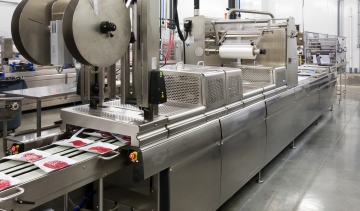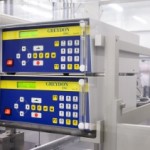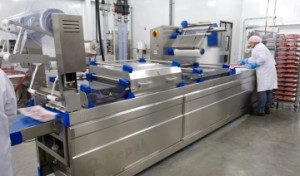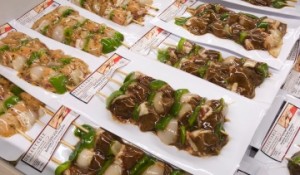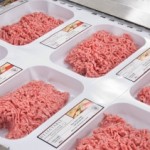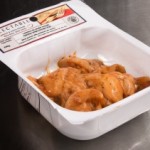
Fresh new beginning
By Andrew Joseph, Features Editor; Pierre Longtin, Photographer
General Amfec Bizerba Canada Inc. Busch Vacuum Technics Carl valentin GmbH Cryovac Fomaco Greydon Inc. Henneken Multivac Canada Reiser S+S Inspection Inc. Sealed Air Corporation SEW-Eurodrive Co. of Canada Ltd. Seydelmann Vianded VP MeatsInnovative Quebec meat processor turns disaster into opportunity to grow its upscale product range with advanced vacuum skin-forming technologies
Sometimes a fresh new start is what a company needs to rediscover its market mojo—even if that means starting totally from scratch.
For Henryville, Que.-based Viandes VP Meats, that rejuvenation process could not have commenced under more troubling and disastrous circumstances—namely a devastating fire that completely destroyed what was at the time a spanking-new, state-of-the-art, 45,000-square-foot production plant, freshly certified as a federal facility by the Canadian Food Inspection Agency (CFIA) to enable the company to expand its markets outside of Quebec to other Canadian provinces.
“At that time we were only able to sell our products within the Province of Quebec due to our [former] facility’s certification,” company president Guy Paquette told Canadian Packaging in a recent interview, referring to the company’s original, 10,000-square-foot production plant that was already running at full capacity, offering virtually no room to grow for a business that clearly had its sights on expanding its marketing reach in
a major way.
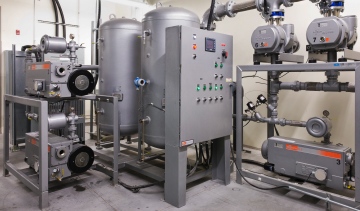
A partial view of the massive Busch Vacuum Technics central vacuum system employed to manage the operation of all the VP Meats vacuum-based packaging machines.
Originally founded in 1985 by four Paquette brothers—Guy, Robert, Jacques and Mario—the upstart company was in many ways the siblings’ way of paying tribute to their father: a self-employed professional butcher who eventually expanded his craft into a successful grocery store enterprise.
With business going briskly over the years, the company relocated a couple of times to accommodate growing volumes, making a fateful decision to construct a brand new building from which it could proficiently serve the entire Canadian market and beyond.
“Since we wanted to expand across Canada, we simply had no choice but to construct ourselves a new facility that would allow us to not only increase our capacity, but also our market base and reach,” Paquette relates, recalling the massive fire on May 7, 2009, which gutted the entire facility just prior to its official opening.
“We were lucky that no production had begun at the facility at that time, and that no staff were inside,” states Paquette. “The only thing we could do after getting over the shock was to start building again.”
And much along the lines of the mythical phoenix rising from the ashes, build again they did—constructing a brand new greenfield, $16-million facility over about 10 months to restart the company’s production in late 2010, according to Paquette.
Currently employing 85 full-time people, the 82,000-square-foot, fully HACCP (Hazard Analysis Critical Control Points)-certified building is not only an impressive physical structure—housing elaborate processing equipment used to turn over 30,000 kilograms of meat per week into a broad range of value-added beef, pork, chicken and veal products—but it is also a showcase of environmental manufacturing sustainability, according to Paquette.
“When the fire completely destroyed our plant, we didn’t want to simply rebuild—we wanted to redesign it and make it into an environmentally-friendly facility that everyone could be proud of,” states Paquette, complimenting the phenomenal architectural work turned in by Michel Pérusse Architecte during the design and construction stages.
“We tried to examine every detail of the building to see if we could improve the quality of the workplace while simultaneously bolster the building’s energy performance.”
One of the key features of the VP Meats facility is its new Eco Chill ammonia and glycol-based refrigeration unit—manufactured by Toronto-based CIMCO Refrigeration a division of Toromont Industries Ltd. of Concord. Ont.—that not only helps with the quick freezing of the products, but also aids in the lowering of energy consumption within the facility by collecting and recycling the heated energy from the refrigeration unit, and then reusing it to warm the flooring on the loading docks and the employee terrace.
“This new heat recovery system is able to reduce our energy dependence by some 2.5 million kilowatt-hours per year,” notes Paquette, adding that by using ammonia and glycol, the Eco Chill system completely eliminates the need to use freon, a gas known to be harmful to the ozone layer.
The building is managed by 760 energy control points and uses a water recovery system that helps VP Meats save thousands of gallons of water per year, according to Paquette, reasoning that a production
plant that provides for a cleaner environment profile also naturally provides for a cleaner and healthier environment for manufacturing the company’s products.
Now generating annual sales of over $10 million, the new plant currently operates one shift over a five-days-a-week schedule, the company is considering adding a second line to keep up with the production demands, as well as for an impending launch of a new, ready-to-eat meals project VP Meats has planned for the near future.
Boasting six processing lines and eight packaging lines—three skin-pack; two thermoskin-pack; and one each of thermoforming, vacuum-sealing and MAP (Modified Atmosphere Packaging)—the new VP Meats facility was installed with what Paquette calls “the newest and best equipment in an effort to not only provide a better workplace for our employees, but to also provide a safer product in a better quality package for our customers.”
Paquette says that 90 per cent of VP Meats’ output is currently sold via its own flagship Delectables brand at the company’s Viandes VP Meats shop, with the balance of production co-packed for clients throughout Canada, the U.S., Central America, the Caribbean, Mexico and Russia.
Naturally, product safety takes paramount priority at the VP Meats plant, which took care to reduce the chances of any accidental product cross-contamination by separating its chicken production area from the other meats production lines, as well as adding a high-performance air filtration system to remove dust and smells from within the facility, and then thoroughly filtering it to eliminate foul odors from escaping out the building’s exterior.
According to plant manager Alain Daigneault: “The new facility exceeds current CFIA standards.

A Greydon S-107/128 Series printer applies all nutritional data, production codes, cooking instructions, product name and other product information.
“It features a cutting edge computerized tracking system for products in case a product recall happens; it has a cooking room that meets the highest standards in hygiene; and we have even made sure that the water we used during the manufacture of our products is treated and filtered via an ultraviolet (UV) ozone-coal process,” Daigneault explains.
Portion Control
As a company specializing in providing controlled portion cuts of its beef, chicken, pork and veal products to grocery stores, supermarkets and the hotel and restaurant segments, VP Meats has always required precise portioning of its products and safe, reliable packaging.
After the portioned meat cuts go through all the stages on one of the eight packaging lines, the meat packages are conveyed to the plant’s freezing system via an inhouse-designed vertical conveyance system powered by eight SEW-Eurodrive motors.
The plant’s new freezing unit can handle between 8,000 and 10,000 kilograms of meat per hour, Daigneault relates, which is moved along the two spiral conveyors and five quick-freeze blast freezers that cool the products to the appropriate temperature within 15 minutes to avoid crystallization between the meats and the package.
“Ultimately, the goal behind great packaging like this is to ensure the vitamins and nutrients are sealed and not lost during the packaging process,” explains Daigneault. “And our new cooling system is cooler than cool!”
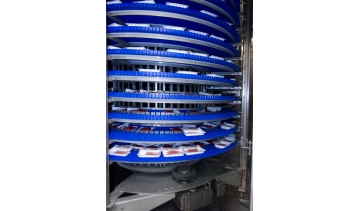
Powered by eight SEW-Eurodrive motors, a spiral conveying system designed by VP Meats moves packages of product into a quick-freezing unit, capable of handling up to 10,000 kilograms of meat per hour, before heading down a second spiral conveyor to secondary packaging.
Designed and built in Canada by Busch Vacuum Technics, the VP Meats plant’s new central vacuum system employs five high-efficiency vacuum pumps located remotely off the production line floor in a configuration that provides many key benefits, including:
• higher productivity, because the machines can run at faster speeds as additional vacuum capacity is installed;
• system fail-safe in case of pump failure, as production is reduced but does not stop;
• heat load reduction to enable considerable energy savings in the refrigeration system;
• lower maintenance costs, thanks to pumps not being exposed to daily washdown. Because the pumps are now kept remotely in a warmer room there is less internal condensation, according to Daigneault, adding that the purchase of the expansion module allows for any pump to be shut down for service without interrupting production by having the other pumps pick up the temporary slack.
• reduced noise levels on the shop floor, thanks to the pumps being centralized in a separate room;
• more floorspace in the production area and improved layout efficiency.
Says Robert Laforest, national sales and marketing manager at the Boisbriand (Montreal) office of Busch: “The innovative meat-processing plants are always on the lookout for ways to increase production line efficiency.
“Utilizing the correct vacuum generation system not only improves their cost-effectiveness, but also provides for a better all-around package,” says Laforest, adding that removing all vacuum generators from the packaging room effectively eliminates the risk of potential cross-contamination of the food products through oil aerosols.
“An added bonus is that for standard maintenance or repair work, employees do not need to enter the packaging area, enabling the room to maintain its hygienic conditions,” says Laforest, noting that the R 5 series vacuum pumps developed by Busch have become the global standard used by food vacuum packaging machines.
Originally developed by company founder Dr. Ing Karl Busch back in the 1960s, Busch vacuum systems have over the years evolved into the best-of-breed vacuum technology of choice for meat processing operations.
Because VP meats utilizes eight high-speed vacuum packaging machines, Busch advised the installation of a combination of both rough and fine vacuum systems for the facility.
According to Busch, individual packaging chambers of the various vacuum packaging machinery are pumped down in two stages to allow it to run at maximum cycle frequencies.
Utilizing a fully-automatic centralized vacuum system, Laforest says, activates individual vacuum modules whenever a greater vacuum is required.
Conversely, it can switch off individual vacuum modules should a less powerful vacuum be required.
A failsafe in the system also allows for a reserve pump to be automatically activated should a vacuum pump fail at any station, allowing the rest of the vacuum generating system to continue working for all the packaging machines.
With regards to maintenance, the centralized Busch vacuum system was designed to be modular, meaning that when an individual vacuum segment is taken off-line for maintenance, a reserve unit automatically kicks in.
“It means that maintenance can be carried out here in the upper floor where the vacuum system is housed without any affect to the production line,” exclaims Daigneault, adding that because of fewer running hours, the individual rotary vane vacuum pumps are subjected to less force relative to individual units, thereby extending the maintenance intervals.
Daigneault was also quite high on the company’s Greydon, Inc. printer systems on the production lines.
Move Forward
“Our marketing philosophy was for us to move forwards to create the nicest CFIA-approvable retail package of vacuum packed meat portions with improved visuals on the front side while still being able to conform with the new regulations of providing product information on the back without having to utilize too much of a paper label that might hide the packaged meat portion,” explains Daigneault. “Greydon helped us achieve that goal.”
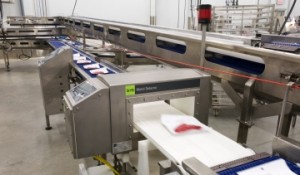
One of nine S+S metal detection units used by VP Meats to ensure all of its products are completely contaminant-free.
Greydon installed three complete line systems, including six S-107/128 Series printers, three labelers, three Advance Trax and three complete bracket systems.
Greydon was also asked to design and manufacture a complete printing system to allow VP Meats to produce a finished package for the fresh deli meats products, including all of the government-required data such as the product description, contents, nutritional facts, production codes, expiry dates, and a scannable barcode for 200 SKUs (stock-keeping units).
According to Greydon vice-president John Rochon, “In order to achieve these goals, we needed to mount the printers to the back of the packaging machines.”
Each of the six S-107/128 Series traversing thermal transfer printers can print a five-inch programmable message across the width of the web.
In addition to a cross-web labeler, each of the three printing lines uses an Advance Trax unit that employ a series of gears and rollers to move the web independently from the packaging machine during the dwell cycle to enable an additional second row of printing.
Rochon explains that on each line, the first thermal-transfer S-107/128 Series print: the ingredients, nutritional facts, lot and expiry date, and the barcode directly onto the outside of the bottom of the film web.
The cross-web labeler then adds a generic label on the top side of the bottom web. The second thermal transfer unit then prints the product description onto the top of the label to provide a finished product.
“VP Meats can print over 200 different product labels with one bottom web film and one generic label to eliminate the need for any expensive preprinted films and labels,” says Rochon. “It also helps reduce the long lead times.”
Daigneault concurs: “It was also key for us that VP Meats be able to print directly onto both sides of the package and/or be able to print on a header label and apply it positioned perfectly onto the package header.
“It is all controlled within the system’s memory for each of our 270 different SKUs.”
The Greydon systems utilized by VP Meats employ the Labelstar PLUS graphic label design software, designed by Carl Valentin GmbH, which allows processors to easily create and modify their packages as needed.
Another challenge for VP Meats was that the Greydon systems had to be fitted to the new packaging machines like the Multivac R 275 CD, a Reiser Repak RE 20/6, and to the existing Reiser DixiePak DP-50E skin packaging machine.
“We didn’t realize at first that our list of requirements for these systems was so sophisticated, but we were fortunate to have knowledgeable Greydon specialists in Montreal who came up with a solution that not only met our project requirements,” explains Daigenault. “Greydon was also able to offer added features such as bottom film registration control; web shifting to accommodate all of our rollstock machines dividers; film dusting with static control; one-color fully programmable surface side printing of the package including logos, nutritional facts, ingredients; and whatever else we need or want, like one-color registered printing on the header side of the film and/or the label with a registered label applicator.”
Daigenault says that when he and his colleagues had an opportunity to travel to Germany to see and operate a Multivac thermoform packaging machine, they walked away thinking it was perfect for their needs.
The visit led to a purchase of a Multivac R 275 CD thermoformer which VP Meats uses to create the DARFRESH vacuum skin packaging process utilizing DARFRESH films manufactured by Sealed-Air’s Cryovac division.
The new DARFRESH process utilizes special top and bottom films that, when applied via the R 275 CD thermoformer, create a vacuum skin that surrounds and seals the product to not only provide the consumer with a true shape and a visual of the product’s texture, but it also provides a longer shelf-life with a highly durable cover.
The R 275 CD thermoformer works by evacuating the air from the chamber that causes the top film to move to absorb heat and to form a dome. After a gentle airf low is introduced, the top film relaxes so that it can flow over the product to the bottom film or tray, as in the case of VP Meats.
When the dome opens and the top web contracts, it provides a skin-tight barrier that follows the product’s contours. Finally, the top and bottom films are then heat-sealed to each other by the Multivac thermoformer right up to the product’s edges to ensure a safe and hygienically-sealed pack.
The stainless-steel Multivac R 275 CD has been designed specifically to work at medium- to high-volume vacuum processes.
“We can run the R 275 CD at up to 10 cycles per minute,” says Daigneault, “but since the machine can process six products at a time, it actually packs up to 60 packs a minute.
“That is very fast,” he says, “and is one of the reasons why we have been able to double our production in the past year, and hope to double it again in 2012.”
The R 275 CD thermoformer provides the user with a smooth, sloping IP 65 hygienic design without recesses, corners or sharp edges to make it easy to do a full washdown to the inside and outside of the machine. It also boasts easily accessible side panels to clean, and sufficient space to allow thorough cleaning of all equipment parts like the chain guide, chain and motors.
And according to Multivac, the R 275 CD, like all of its thermoformers, is certified for numerous international hygienic standards.
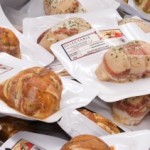
Baconwrapped meats in Sealed Air Cryovac’s DARFRESH skin-packs are produced on the Multivac R 275 CD thermoformer.
Says Daigenault: “We bought the Multivac R 275 CD in 2009 for a variety of reasons, including the hygienic benefits it could offer, and we have not been disappointed.
“Along with that, we have been very happy with its ease-of-operation, and have also been impressed with how quickly it packages our products in a form that is visually appealing to the customer.”
Production-wise, the R 275 CD is simple to operate with a touchscreen control panel that features a data acquisition and storage feature to make repeating package designs quick and easy to setup.
Featuring strong and reliable lifting systems, the R 275 CD offers a maximum cut-off length of 640 millimeters.
The plant also employs a Multivac T 350 traysealer, likewise purchased in 2009, to perform MAP for its natural and marinated beef, chicken, pork and veal product packs.
“While the R 275 CD is used heavily for our Delectables brand, we use the T 350 to pack product for our contract packaging customers,” explains Daigneault. “While it generally only runs at about six cycles per minute, it provides the perfect package our customers desire, and keeping the customer happy is always a good thing.”
Another line at VP Meats utilizes the Repak RE20/6 horizontal form/fill and seal packaging machine, purchased in 2009 from Reiser Canada, that is used to create vacuum skin-packs and thermoskins.
Constructed from stainless steel, the Repak RE20 utilizes its compact modular design to provide a simple way to perform a full hygienic washdown process to prevent the accumulation of water, cleaners or particulates.
The Repak RE20 uses the rapid air formation process to fully distribute the web throughout the product, with an efficient use of film that can provide the user with thinner film applications that can save it some 20 per cent in cost.
Considered to be a small machine, Reiser nonetheless ensured that the Repak RE20 has been constructed in the same exacting manner as the larger machines, utilizing the same reliable die-lift technology, the same strong frame design, and the same operator-friendly interface.
Other important equipment at VP Meats includes the rugged stainless steel Reiser Rotoclaw II frozen meat block breaker that breaks up frozen chunks of meat without damaging the product’s texture, thanks to its low-speed rotor that breaks the block into smaller pieces.
Able to handle frozen blocks up to 9.5-inches-thick and 21-inches-wide, the Rotoclaw II can, depending on the piece sizes, process up to 4,540 kilograms of product per hour without generating a lot of noise.
New Toys
In adition, Reiser also sold VP Meats its Vemag MMP220 ground meat portioner that automatically places ground meat onto paper to convey it to a vertical cutting blade that portions it consistently in a uniform shape and to an accurate weight.
For its part, the newly-purchased Vemag HP20E vacuum filler for sausages uses a positive displacement double-screw pump to quickly and gently provide accurate portion control.
“We have had great service from Reiser,” says Daigneault, noting that Reiser also supplied two Fomaco FGM26 injectors for meat marinating;
• a Seydelmann AE130 meat grinder;
• a pair of tumblers manufactured by Henneken and Amfec;
• a Reiser Repak RE15 form/fill/seal packaging machine.
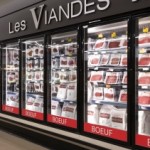
The frozen-meat section at the Viandes VP Meats grocery store in Saint-Jean-sur-Richelieu offers a huge selection of the processor’s upscale packaged products.
Another company that has impressed Daigneault is S+S Inspection, a prominent food inspection systems manufacturer, who worked with Bizerba Canada to install nine new metal detection units at the facility.
“They provide us with another boost of high-level confidence in knowing that our products are safe,” says Daigneault. “We have nine of them because we trust them to do the job.”
Coming full circle to its roots, VP Meats has set up its own grocery store in nearby Saint-Jean sur-Richelieu as a tip-of-the-hat to the hard work and dedication of their father’s profession.
“While the shop does sell a host of other meat products, it is also an excellent showcase for many of our Delectables products,” sums up Paquette. “And while I am proud of this shop, I am also very pleased with our processing facility that enables us to keep this shop and those of our customers with our great products in great packaging.”
Advertisement


